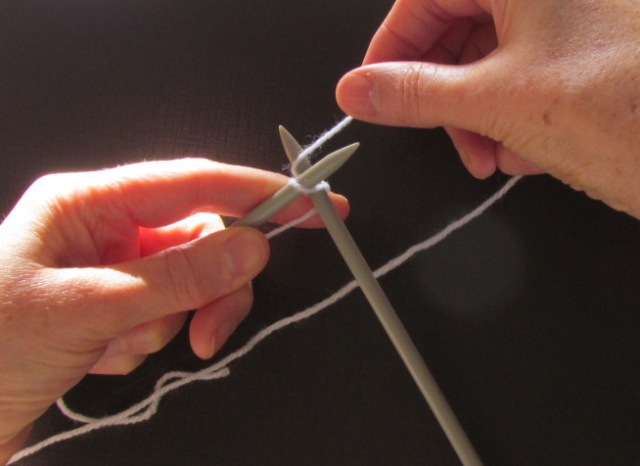How to
Cast on Knitting

Learning how to cast on knitting can seem daunting but the steps can be taken one by one.
Firstly you need to get the wool or yarn onto the needle and this begins with making a slip stitch which is the start of getting all the stitches required for your project.
This could be a small amount of stitches if making something for a teddy or baby or it could be a large amount of stitches if making a jumper for an adult.
Beginners to knitting should always start with a smaller item as this will be made quicker. A larger knit would take a long time.
My first knit was a plain stocking stitch polo necked jumper and although it taught me how to do the stitches, it also took me 4 years to complete.
From this slip stitch all the other stitches are made and this process is called "casting on". There are different methods of casting on some by using the needles and others using your fingers. I have always been used to using the needles which will be shown on this page.
The knitting needles come in different lengths so chose one that will take all your stitches comfortably and not all crunched together although if you are making a large item this is sometimes unavoidable. Be careful they don't fall off!!
The needles are also made out of different materials, some metal, wooden or plastic. At times the stitches can stick on the needles if they have been cast on too tightly.
Patterns also show instructions as abbreviations so it is good to get to know these and once you have made a few things you will soon remember them.
Steps to making the slip stitch in pictures.


To make a slip knot secure the end of the yarn with your thumb on one hand and wrap the yarn around the fingers of the hand that is holding the end. When you take the yarn to the back of the hand loop the yarn under the strand that is already there and pull through.
This can also be done by wrapping the wool around your fingers and not your hand.

How to Cast on Knitting - video
Casting on in Step by Step pictures.

1) Make a slip knot as above and place onto the needle. The part of casting on is to make additional stitches from that first one until all the stitches needed are on the needle. This could range from ten for a dolls scarf to over a hundred if a jumper is being made.

2) Take spare needle and loop it into the slip knot keeping it on the first needle. Both needle ends are now in the slip knot.

3) Take yarn attached to the ball and not the small end, wrap yarn around spare needle so it ends up between both needles.

4) Carefully bring spare needle back so it nearly comes out of the loop but then catches the strand that lies between the needles.

5) As it does so move the spare need forward to make another loop from the strand of yarn.

6) Pull new loop and slip onto the first needle tighten the loop onto the first needle by pulling strand of yarn.
Continue as from step 2 to cast on the required amount of stitches for your project and practise casting on so the tension is just right.
The first stitch to learn is a knit stitch as this is the basis of knitting. Another basic stitch is the purl stitch. Other patterns can be made using these stitches in different ways and it is a good place to start trying increasing, decreasing or casting off stitches.
Enjoy....
- Home
- Knitting for Beginners
- How to Cast on Knitting
Affiliate offers
Please take care with any soft furnishing that it does not come into contact with any heat source.
If you have found an error on this page or want some more information on sewing cushions.
Please contact me . Thank you



New! Comments
Have your say about what you just read! Leave me a comment in the box below.